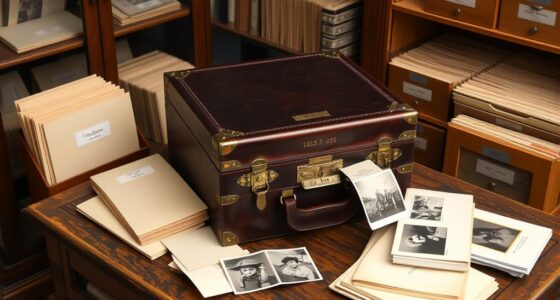To navigate genealogical archives and repositories effectively, start by understanding the different collection types like original documents, microfilms, and digital records. Use digital catalogs to locate records by names, dates, or locations, and take advantage of online access for pre-visit planning. Follow preservation guidelines and handle materials carefully to protect them. If you keep exploring, you’ll uncover even more tips for making your research smoother and more successful.
Key Takeaways
- Utilize digital catalogs and online search tools to locate relevant records before visiting the archive.
- Understand archive organization and indexing systems to efficiently navigate collections.
- Follow handling guidelines to protect fragile materials and ensure responsible use.
- Use metadata and summaries in digital records for effective pre-research planning.
- Prioritize preservation techniques, such as proper storage and digitization, to maintain collection integrity.

Genealogical archives and repositories serve as essential resources for anyone researching family history. When you dive in these collections, you’ll find a wealth of information stored in various formats—original documents, microfilms, photographs, and digital records. To navigate this vast landscape efficiently, understanding how these collections are organized is crucial. Many repositories employ digital cataloging systems, which make searching for specific records much easier. These systems index documents by names, dates, locations, and other relevant details, allowing you to pinpoint the materials you need without sifting through physical stacks. Using these digital tools effectively can save you hours and help you uncover previously overlooked records. Familiarizing yourself with how records are cataloged digitally can greatly enhance your research efficiency, especially since many institutions provide online catalogs that can be accessed remotely.
Digital cataloging systems streamline genealogy research by indexing records for quick, efficient access.
As you explore these archives, you’ll notice efforts to guarantee the longevity of historical materials through preservation techniques. Preservation is essential because many records are fragile, deteriorating, or susceptible to damage over time. Repositories utilize various methods—such as controlled environments with ideal temperature and humidity, acid-free storage containers, and careful handling protocols—to protect these precious documents. Some archives also digitize their collections, which not only makes records more accessible but also helps safeguard the originals from excessive handling. When you access digital copies, you’re less likely to cause wear and tear on the physical items, guaranteeing they remain available for future generations.
Familiarizing yourself with how records are cataloged digitally can greatly enhance your research efficiency. Many institutions have online catalogs where you can browse or search for specific ancestors, locations, or time periods before visiting in person. This pre-search capability allows you to plan your visit more strategically, concentrating on collections most relevant to your family history. Additionally, digital cataloging often includes metadata—such as summaries, contextual information, and references—which can provide valuable insights even before you examine the actual documents. Understanding preservation techniques also helps you appreciate the importance of handling records carefully when you’re physically present. When examining fragile papers or photographs, use gloves if recommended, and avoid unnecessary exposure to light or moisture. Respect the guidelines set by the archive to maintain the integrity of their collections. If you’re working with digital copies, remember that they are often enhanced or indexed to facilitate research, but they should still be used responsibly to avoid any accidental damage through improper handling of the original materials.
Frequently Asked Questions
How Can I Access Archives From Different Countries?
You can access archives from different countries through digital access options, which many repositories now offer online. Start by exploring official national and regional archive websites; they often provide digital collections or links to international cooperation projects. Additionally, joining genealogical societies or online forums can connect you with experts and resources across borders, making it easier to access international archives and expand your research globally.
What Are the Costs Associated With Archive Visits?
When visiting archives, you’ll encounter access fees that vary depending on the repository and the materials you wish to view. Some archives charge per visit, while others offer membership options that reduce costs over time. Membership costs typically include unlimited access or discounted rates, making frequent visits more affordable. Always check the archive’s website or contact staff beforehand to understand specific fees and membership details, ensuring you plan your budget accordingly.
How Long Does It Take to Get Archive Materials?
Think of archive materials as seeds awaiting growth; it takes time for them to bloom. Depending on archival processing, you might wait days or weeks for your requested items. Your researcher patience is key, as staff work diligently behind the scenes to locate and prepare records. While delays can test your resolve, understanding this process helps you stay focused on the eventual reward—a glimpse into your ancestors’ lives.
Are There Online Catalogues for All Repositories?
Not all repositories have online catalogues, but many now offer digital access to their collections. You can often search their databases from home, saving you time and effort. Repositories use preservation techniques to protect fragile materials, ensuring long-term access. Keep in mind, some archives may require in-person visits for certain documents, but online catalogues are expanding, making it easier to find your ancestors’ records from anywhere.
Can I Request Copies of Documents Remotely?
Yes, you can request copies of documents remotely, opening a window to your ancestors’ stories from anywhere. Think of digital access as your key to unseal archives without stepping inside. Simply follow the request procedures outlined by each repository—often submitting online forms or emails. With a few clicks, you’ll receive copies via email or mail, making your genealogical journey smoother and more accessible than ever before.
Conclusion
As you close the dusty covers of these archives, imagine the whispers of ancestors echoing through time, guiding your journey. Each record, a thread woven into your family’s tapestry, invites you to trace your roots with curiosity and purpose. Let the quiet rustle of pages and the faint scent of history carry you forward. In every document, you find a part of yourself, connecting past and present in a seamless, enduring rhythm.







